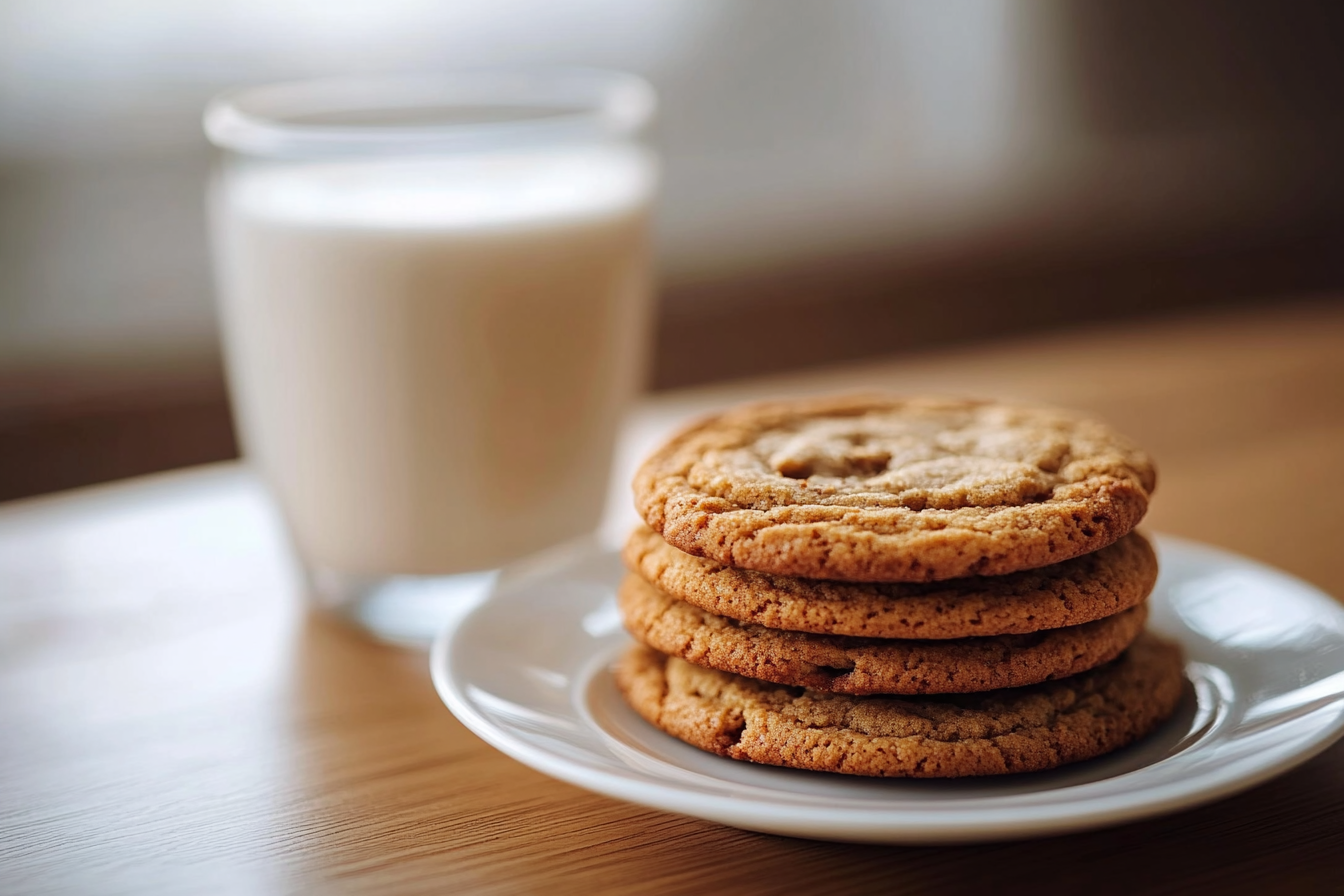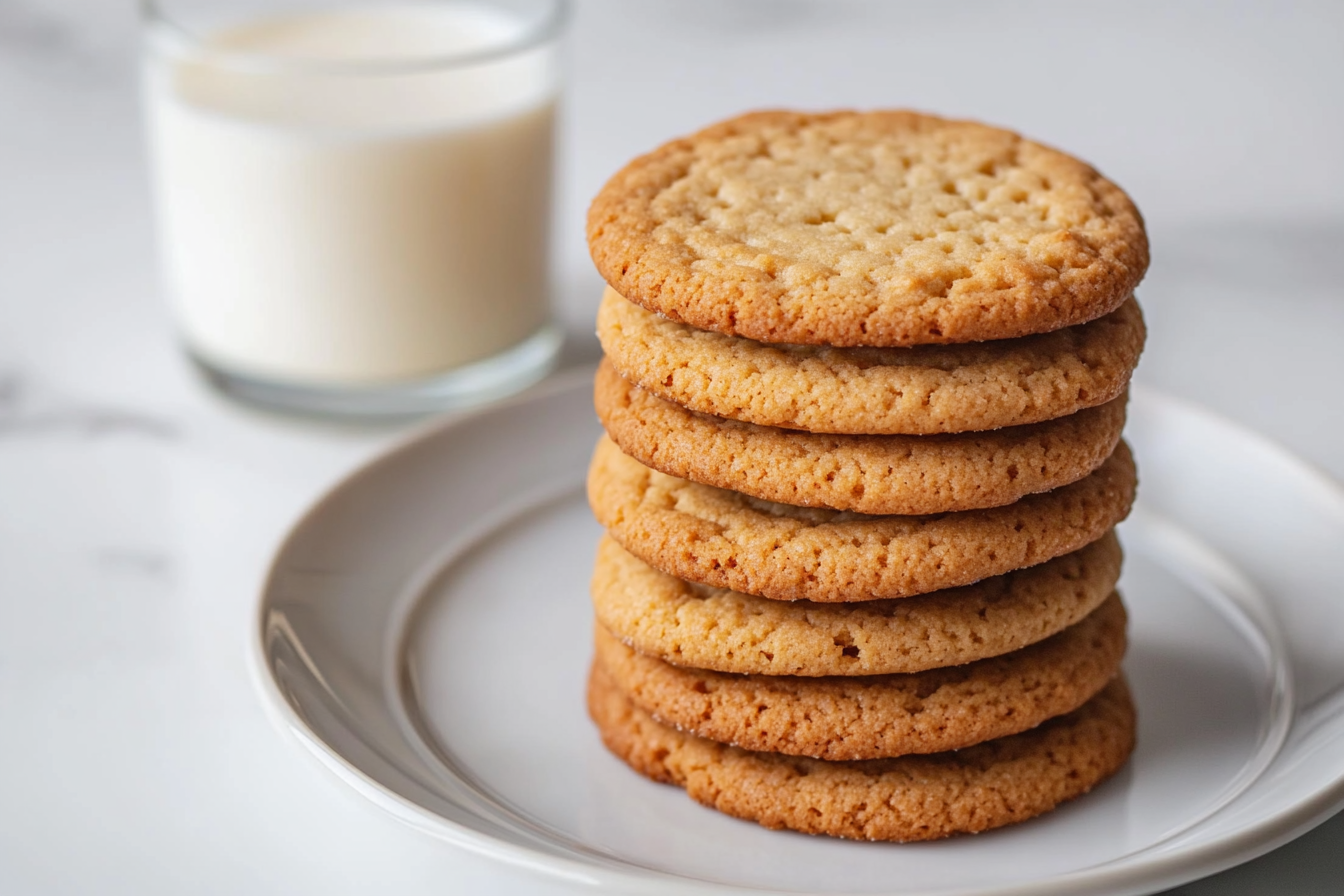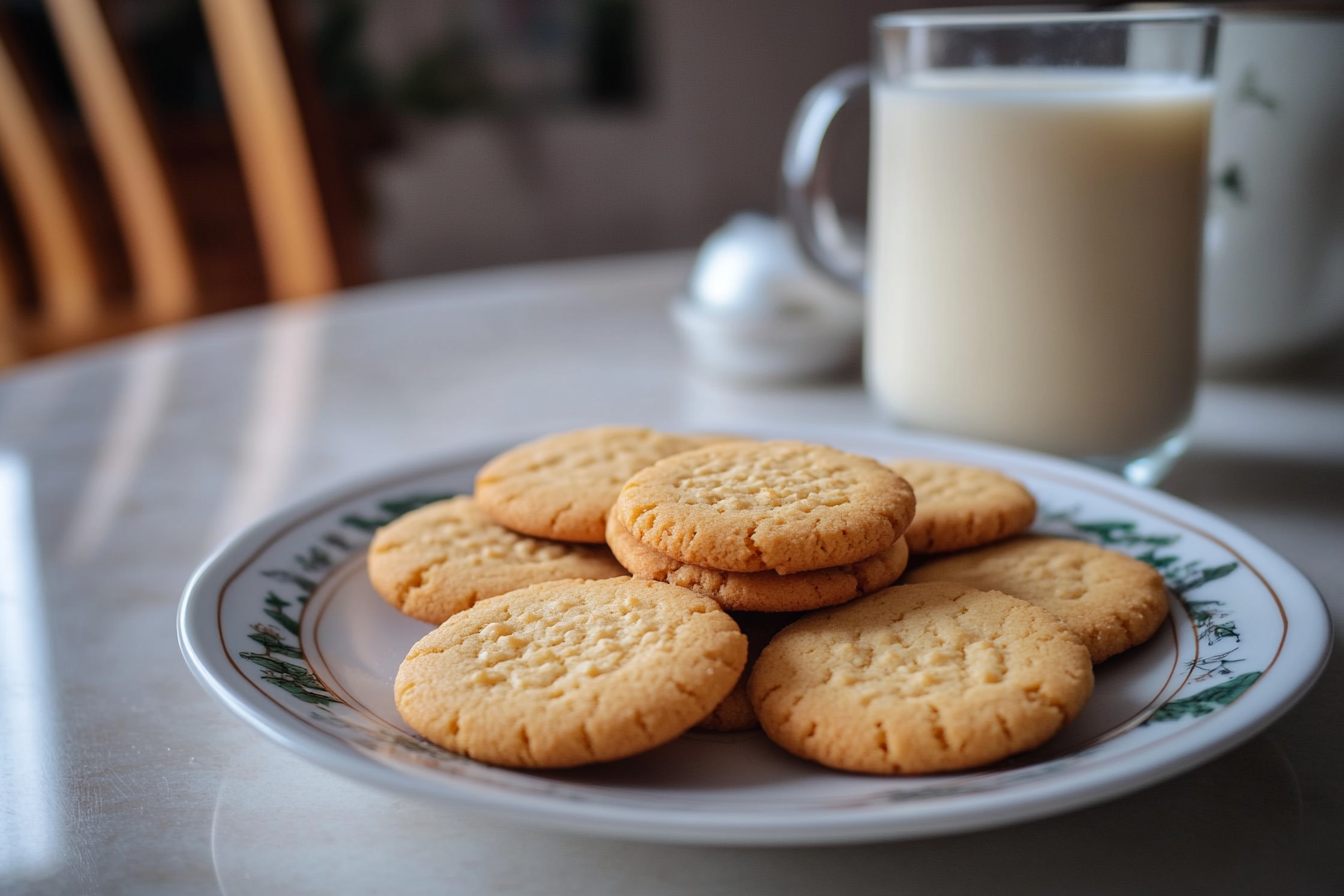Milk cookies are a delicious and comforting treat enjoyed by many around the world. Have you ever wondered what is Milk Cookie made of? In this article, we’ll explore the simple ingredients that go into making this delightful dessert. Whether you’re curious about the recipe or interested in trying new variations, this guide will answer all your questions about what is Milk Cookie made of.
This article will explore the ingredients used to make milk cookies, provide a step-by-step recipe, dive into different variations, and offer serving suggestions. You’ll also learn how these cookies compare to other popular cookie types.
The Origins of Milk Cookies
Milk cookies have been a favorite in various cultures for generations. But regardless of where you’re from, if you’ve ever wondered what is Milk Cookie made of, the answer lies in a few basic ingredients: flour, sugar, eggs, and, of course, milk. These ingredients combine to form a soft and tender cookie that pairs well with coffee, tea, or milk.
In Japan, milk cookies are highly prized for their delicate, melt-in-your-mouth texture. Their light flavor appeals to many, and they have become a popular packaged snack in Japanese culture. As a result, Japanese bakeries often offer these cookies, which feature a smooth, creamy taste that people of all ages enjoy.
Bakers around the world continue to adapt milk cookies to suit local tastes and preferences. Whether in small-town bakeries or large urban kitchens, milk cookies remain a timeless dessert.
What Are Milk Cookies Made Of?
So, what is Milk Cookie made of? The answer is simple. Bakers use a few everyday ingredients to create this treat:
- Flour: All-purpose flour is the standard, but you can also substitute whole wheat or gluten-free flour for dietary needs.
- Sugar: Cane sugar is common, but you can substitute it with brown sugar or honey to add a richer flavor.
- Eggs: Eggs provide structure and moisture. For a vegan option, you can substitute flaxseed eggs, applesauce, or mashed bananas.
- Milk: Milk adds moisture and helps bind the ingredients. Use dairy or plant-based milk, such as almond, soy, or oat milk, depending on your preference.
- Vegetable Oil: Use neutral oils like peanut or canola to keep the dough soft and moist. For added richness, you can use butter instead of oil.
- Citrus Zest: Lemon or orange zest brightens the flavor of the cookies and adds a subtle freshness.
- Baking Powder: Baking powder acts as a leavening agent, helping the cookies rise and become light.
- Vanilla Extract (optional): Vanilla extract adds depth to the flavor.
interested in more simple and easy recipes, you can also check out our best birthday cake ideas and tips for more delicious desserts.
Ingredient Substitutions and Variations
You can easily adapt the basic recipe for milk cookies by making a few ingredient changes:
- Flour Alternatives: Almond flour or coconut flour work well for gluten-free cookies. Keep in mind that these flours absorb more moisture, so you may need to add extra milk or oil to maintain the right consistency.
- Sweetener Alternatives: Instead of using refined sugar, you can opt for natural sweeteners like honey, agave, or maple syrup for a more wholesome flavor.
- Egg Substitutes: If you’re following a vegan diet, you can replace eggs with flax eggs or mashed bananas. These substitutes will provide the necessary binding without altering the texture too much.
- Milk Options: Almond, soy, or coconut milk can replace dairy milk for a lactose-free or vegan version of milk cookies.
How to Make Milk Cookies
The process of making milk cookies is simple and quick. You can finish the entire recipe in under 30 minutes, making these cookies a great option for last-minute baking.
Ingredients:
- 250g all-purpose flour (or gluten-free flour)
- 80g sugar (can be replaced with honey or maple syrup)
- 1 large egg (or flax egg for a vegan option)
- 50ml vegetable oil (or butter for added richness)
- 30ml milk (dairy or plant-based)
- 1 teaspoon lemon or orange zest
- 8g baking powder
- 1 teaspoon vanilla extract (optional)
Instructions:
- Preheat your oven to 350°F (180°C). Line a baking sheet with parchment paper.
- Sift the flour and baking powder into a large bowl, adding a pinch of salt.
- Whisk the sugar, egg, milk, oil, and vanilla extract together in a separate bowl.
- Combine the wet and dry ingredients, stirring until a dough forms.
- Shape the dough into small balls (about 1 inch in diameter) and place them on the baking sheet.
- Chill the dough in the refrigerator for 15 minutes to help the cookies maintain their shape.
- Brush the tops with milk and sprinkle with sugar for extra sweetness.
- Bake for 15-20 minutes, until the cookies turn golden brown.
- Cool the cookies on a wire rack before serving.
Tips for Success:
- Avoid overmixing the dough, as this can lead to tougher cookies. Mix just until combined.
- Chilling the dough before baking helps prevent the cookies from spreading too much in the oven.
- Use a cookie scoop to ensure that all your cookies are the same size, allowing them to bake evenly.
Health Benefits and Nutritional Information
Milk cookies can be enjoyed as an occasional treat, and you can make them healthier by tweaking a few ingredients. Here’s a general nutritional breakdown for one milk cookie:
- Calories: 100-150 per cookie
- Carbohydrates: 12-18 grams
- Fat: 5-7 grams (depending on the type of oil or butter used)
- Protein: 2-3 grams
- Fiber: 1-2 grams (using whole wheat flour adds more fiber)
You can improve the nutritional profile of these cookies by using whole wheat flour instead of white flour, which increases the fiber content. For example, using natural sweeteners like honey or coconut sugar reduces processed sugar levels while still maintaining a rich, sweet taste.
If you’re interested in making lactose-free or lower-calorie versions, use almond milk or oat milk instead of dairy milk. These substitutions won’t compromise the flavor or texture, and they help cater to dietary preferences.
Variations of Milk Cookies
Milk cookies provide a perfect base for experimenting with different flavors and textures. You can easily adapt the recipe to suit various diets or taste preferences.
Vegan Milk Cookies
To make vegan milk cookies, replace the eggs with flaxseed eggs or applesauce. Use almond milk or oat milk in place of dairy milk, and substitute the butter with coconut oil or vegan margarine.
Gluten-Free Milk Cookies
For gluten-free milk cookies, use almond flour or a gluten-free baking mix instead of all-purpose flour. You may need to adjust the amount of liquid in the dough to achieve the desired consistency, as gluten-free flours absorb more moisture.
Flavored Milk Cookies
Add variety to your milk cookies by incorporating new flavors. For example:
- Chocolate milk cookies: Add 2-3 tablespoons of cocoa powder to the dough for a rich, chocolatey flavor.
- Spiced cookies: Add cinnamon, nutmeg, or ginger to give your cookies a warm, cozy flavor.
- Nuts or dried fruit: Stir in chopped almonds, walnuts, or dried cranberries for added texture and flavor.
You can also experiment with adding shredded coconut or vanilla beans for a more exotic flavor profile.
Serving Suggestions and Pairings
Milk cookies are a versatile treat that pairs well with various beverages and other desserts. Here are a few serving ideas:
- With Coffee or Tea: Milk cookies are excellent for dunking in coffee or tea because their soft texture holds up well when soaked in hot liquid.
- With Milk: Pairing these cookies with a cold glass of milk creates a classic combination that many people love.
- As Part of a Dessert Platter: Serve milk cookies on a dessert platter alongside fruits, chocolates, and other baked goods for an impressive display.
- For Breakfast: Enjoy milk cookies with a smoothie or yogurt for a light breakfast option.
Comparing Milk Cookies to Other Cookies
Although milk cookies share similarities with other cookie types, they also have unique characteristics that set them apart. Here’s how they compare to popular cookie varieties:
- Milk Cookies vs. Sugar Cookies: Sugar cookies are typically sweeter and crisper, while milk cookies have a softer, more tender texture due to the inclusion of milk and oil.
- Milk Cookies vs. Butter Cookies: Butter cookies are richer and denser because they rely heavily on butter for flavor. Milk cookies, on the other hand, are lighter and use oil, which keeps them soft.
- Milk Cookies vs. Shortbread: Shortbread is crumbly and dense, whereas milk cookies are light and airy due to the milk and baking powder used in the dough.
FAQs About Milk Cookies
Can I Make Milk Cookies Without Eggs?
Yes! You can use flax eggs, applesauce, or mashed bananas as an egg substitute to make egg-free or vegan milk cookies. These alternatives work well to bind the ingredients and maintain a soft texture.
How Long Do Milk Cookies Last?
Milk cookies will stay fresh for up to a week when stored in an airtight container. You can also freeze the cookies for up to three months. To freeze them, arrange the cookies in a single layer on a baking sheet before transferring them to a freezer-safe container.
What Kind of Milk Should I Use?
You can use any milk for this recipe, including dairy or plant-based milk. Almond milk, oat milk, or coconut milk are excellent substitutes for those who are lactose intolerant or prefer a dairy-free version.
Are Milk Cookies Healthy?
Milk cookies can be a healthier treat if you use wholesome ingredients. For instance, substituting whole wheat flour for white flour increases the fiber content, and using natural sweeteners like honey or maple syrup lowers the amount of processed sugar. You can also use plant-based milk to reduce the overall fat and calorie content.
Conclusion
Milk cookies are a simple yet versatile dessert that can be customized to suit a variety of dietary preferences and flavor profiles. Whether you’re looking to bake a batch of traditional milk cookies or experiment with vegan or gluten-free versions, these cookies are sure to satisfy your cravings. Their light, soft texture and mild sweetness make them a perfect choice for any occasion, from casual snacks to elegant dessert displays.
Now that you know what milk cookies are made of, it’s time to try making them yourself. Enjoy experimenting with different flavors and ingredients, and share these delightful cookies with your family and friends!



